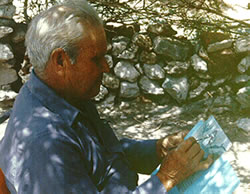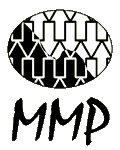Don Vicente Barajas: Retablo painter
Based on an interview conducted by Jorge Durand
As testimonies of personal experiences, retablos
capture the most significant moments in a votary's life. Once placed
on the walls of churches, they become public records that provide
a unique glimpse at the dreams, thoughts, and fears of their
creators. Yet retablos are seldom prepared by the votaries themselves.
These paintings are generally the commissioned works of untrained
local artists who offer their skills to capture the most deep-seated
feelings of their clients.
To this date, little is known about the lives of
retablo painters. Anonymity is a main characteristic of rural artists
like the retablistas. Luckily, a few retablistas do sign their
work, even fewer include an address next to their signature or
on the back of the retablo. This was the case with Don Vicente
Barajas who lives, works, and paints in the ranch of San José de
la Calera, Guanajuato. A retablo from 1969 found at the Sanctuary
of the Virgin of San Juan de los Lagos, contained on the back an
address in the city of León, Guanajuato that helped track
Don Vicente back to his hometown.
 Born
during the Revolution times in 1916, Don Vicente left his native
rancho when he was very young. Migrating to the state of Veracruz,
he found work at the Río Blanco textile factory. Although
he was first employed in the pressing department, it was later
in the electrical plant that he met Don Joaquín Arreola
who, in addition to his factory work, painted and decorated fabrics
in his spare time. Born
during the Revolution times in 1916, Don Vicente left his native
rancho when he was very young. Migrating to the state of Veracruz,
he found work at the Río Blanco textile factory. Although
he was first employed in the pressing department, it was later
in the electrical plant that he met Don Joaquín Arreola
who, in addition to his factory work, painted and decorated fabrics
in his spare time.
The two men began working together and Don Vicente
slowly learned the intricacies of painting. Together they cut pieces
of fabric into one-meter squares and sewed them together to form
cushions and table covers. On these items they painted floral designs
and sold them in the market each Sunday. After a while, Don Vicente
became assistant to another painter and joined him in decorating
churches, painting miniatures, and adorning small religious images.
Later he worked painting leaves, plants, and flowers on cardboard
sheets for a "pharmacist" who used them as advertisements for herbal
medicines he hawked in the market.
Although Don Vicente was quite content in Veracruz,
bad news from home eventually forced his return. Back on his native
rancho in Guanajuato, his liking for drawing and his artistic abilities
soon became known, and he began to attract commissions for votive
works. Don Guadalupe Rangel, from the nearby rancho of Mezquitillo,
was the first to request a retablo -a votive of thanks to the Virgin
of San Juan de los Lagos.
It seems that Don Lupe had been assaulted by bandits
on the highway and his horse was wounded. The animal fell several
times, and in desperation Don Lupe invoked the holy name of the
Virgin. At the last moment, the horse succeeded in standing up
and galloping away from the robbers, who were on foot, thereby
saving his life. Don Vicente listened carefully to the story and
painted a rendition of the miraculous event accompaigned by an
explanatory text. That day in 1942 when Don Vicente delivered his
first painting, he earned three pesos (less than a dollar at the
time) and began his career as a retablista.
In 1942, the United States organized the Bracero
Program to recruit Mexican laborers for temporary agricultural
work north of the border; and like thousands of others from the
state of Guanajuato, Don Vicente joined the wave of men moving
northward. On March 22, 1945, he obtained a Bracero Contract and
set out for el norte for the first time. Over the years,
he traveled back and forth to the United States a total of 26 times,
performing farm work in the states of Arizona, Michigan, Texas,
New Mexico, California, and Nevada.
As a bracero, he combined his talent for art with
his new vocation of migrant worker. Art provided a good way of
earning extra money on his trips away from home, because during
the long train journeys to and from the United States, he could
occupy himself by drawing pictures of fellow travelers and selling
them for modest fees.
He also continued to paint retablos from migrants
who wished to fulfill some vow of thanks to a holy image upon their
return. The votive topics typically dealt with work accidents or
worries about family members so far away. At this stage in his
career, Don Vicente charged $10 per retablo. On his trips to the
United States he always bought new tin sheets, paints, and brushes,
because he preferred American supplies and materials, especially
the brushes.
On one of his return trips to Mexico, he found work
as a painter in a hat factory in San Francisco del Rincón.
At that time Mexican cowboy hats with painted decorations were
in fashion, and there weren't enough people able to paint the intricate
designs. After showing the factory owner some samples of his artwork,
Don Vicente was hired to paint 60,000 hats stored in a warehouse
ar 35 cents per hat. He settled in town for a year or two to work
for the factory, reserving Sundays to paint religious objects that
he sold in the market and at regional fairs.
 Don
Vicente estimates that over the course of his life he has painted
some 5,000 retablos. He still keeps a sign in the Aldama Market
and goes into León each day to pick up new requests and
deliver the retablos he has completed. His clients are ordinary
men and women from the west-central states who seek votives dedicated
to the principal icons of the region: el Señor de Villaseca
in Guanajuato, la Virgen de Zapopan near Guadalajara, la Virgen
de Talpa in Jalisco, el Niño de Atocha in Zacatecas, and
el Señor del Saucito in San Luis Potosí. By far the
largest number, however, are dedicated to la Virgen de San Juan
de los Lagos. Don
Vicente estimates that over the course of his life he has painted
some 5,000 retablos. He still keeps a sign in the Aldama Market
and goes into León each day to pick up new requests and
deliver the retablos he has completed. His clients are ordinary
men and women from the west-central states who seek votives dedicated
to the principal icons of the region: el Señor de Villaseca
in Guanajuato, la Virgen de Zapopan near Guadalajara, la Virgen
de Talpa in Jalisco, el Niño de Atocha in Zacatecas, and
el Señor del Saucito in San Luis Potosí. By far the
largest number, however, are dedicated to la Virgen de San Juan
de los Lagos.
|



